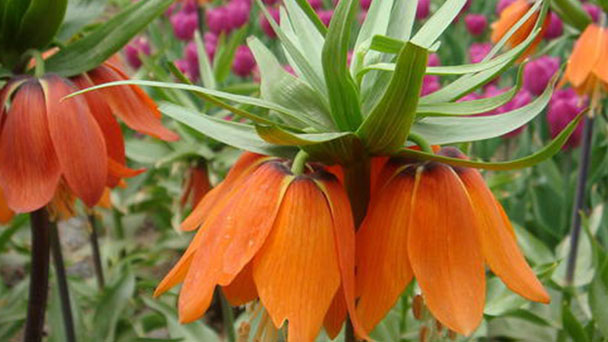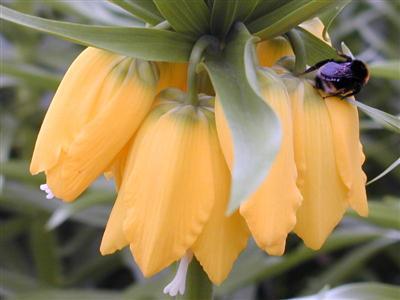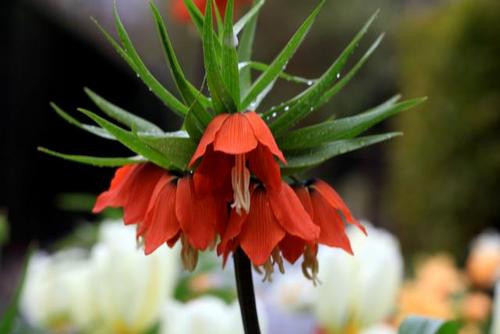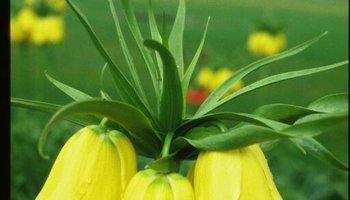Crown imperial (Fritillaria imperialis) profile
Written by Maggie
Mar 17 2021

Crown Imperial (Fritillaria imperialis), also called imperial fritillary or Kaiser's crown, is a perennial herb with a plant height of 70 to 150 cm. Leaves are alternate, ovate-lanceolate to lanceolate, entire. Flowers are bell shaped.
Crown Imperial is said to be the representative flower of Israel, the bishop of Seville in the sixth century. This bishop is very enthusiastic about education. The most important qualification of an educator is patience. The person who loves this kind of flower must also be the person who has strong patience and is naturally suitable for education work. Of course, it will also educate the lover into the type suitable for them. Therefore, the love flower of crown imperial is the patience of love.
Crown Imperial picture

Crown Imperial info
| Botanical Name | Fritillaria imperialis |
| Common Names | Crown Imperial, imperial fritillary or Kaiser's crown |
| Plant Type | Perennial bulb |
| Sun | Full sun to part shade |
| Hardiness Zones | 5, 6, 7, 8, 9 |
| Flower color | Red, orange, yellow |
| Native Area | Asia and Middle East |
| Mature size | One to three feet tall, eight to 12 inches wide |
Morphological features of the Crown Imperial
Crown Imperial is a perennial herb, plant height 70 ~ 150 cm. Leaves are alternate, ovate-lanceolate to lanceolate, entire. Flowers are bell shaped.
Ecological habits of the Crown Imperial
Crown Imperial prefers cool, temperate climates and sandy loam with good drainage. In winter, the aboveground part withers, and the underground bulbs need to protect the overwintering. Crown Imperial can flower continuously for several years. In hot areas in summer, it is difficult for underground bulbs to be stored at low temperature and planted again in autumn.
Crown Imperial propagation
Crown imperial propagation was dominated by meristematic bulbs.
How to grow and care for the Crown Imperial
Light
Crown Imperial prefers full solar (six to eight hours of solar per day) and will additionally develop in semi-shade, woodland conditions.
Soil
Overall, the Crown Imperial is bendy in its capacity to develop in a range of soils from medium (loamy) to heavy (clay) soils that vary from a pH of acid, neutral, or simple (alkaline). Native to places such as the Himalayas and Turkey, it is most pleased grown on cliffs and rocky slopes in well-drained soil. Plant bulbs six to eight inches deep. Replace the pinnacle eight inches of soil with about two inches of compost. Add a layer of sand on top to inspire drainage.
Water
Water solely when vegetation is actively developing in spring. Give them about one inch of water per week. Take care to maintain solely the pinnacle six inches of soil rather moist as the Crown Imperial does not now want an immoderate quantity of water and can tolerate drought.
Pruning, division, and fertilizer
In summer, the foliage will go dormant. Cut the foliage to the floor and compost it if possible. Do no longer water vegetation thru summer, fall, and winter.
In autumn, add one inch of compost on the pinnacle of the mattress and two inches of mulch to insulate the bulbs and preserve weeds down.
Every three to 5 years in autumn, dig up all the bulbs, separate, and replant.
Varieties of the Crown Imperial
Fritillaria Imperialis ‘Maxima Lutea’ is possibly the most famous variety. Its plant life are yellow, developing a crown distinctively dramatic in form.
Fritillaria Imperialis ‘Aurora’ has orange-red flora (as does the Prolifer). The Aurora grows two to three ft tall and is hardy from USDA Zones 5a to 8b.
Fritillaria Imperialis ‘The Premier’ has plants of a softer orange akin to the color of a tangerine, with mild pink veins. It grows between 24 and 36 inches tall.
Fritillaria imperialis 'Aureomarginata' shows an even softer color of orange blooms and twin coloured green-golden foliage comparable to a Spider Plant. It grows up to 36 inches tall.
Fritillaria Imperialis ‘Rubra Maxima’ affords an awesome orange-red that appears caramelized and almost burnt. Flowers are formed like human eyes, included with lengthy pistils and stamen. This plant grows between 40 to forty four inches.
Fritillaria Imperialis ‘Brahms’ has salmon-pink flowers, and in contrast to different varieties, it no longer has the scent to deter rodents and voles.
Fritillaria Imperialis ‘Beethoven’ is a dwarf range developing about two ft tall. It has creamy orange vegetation that develops atop a crimson base and is particularly touchy to water-retentive soil.
Fritillaria Imperialis ‘Bach’ is any other dwarf range developing solely a common of two ft tall. Flowers are crimson with nuanced colorings of orange. In addition to the ordinary potential to deter deer and rodents, the Bach attracts bees like many different bee-friendly flora you can welcome into the garden.

Toxicity of Imperial Crown
According to Plants for a Future, the crown imperial bulb is toxic if eaten uncooked due to the fact it includes low quantities of the toxin alkaloid.
Disease control of Crown Imperial
Rust, leaf back, petiole, stem base appear in many brown spores, the early death of fritillary when the disease is serious. The prevention and treatment method is to strengthen field management, timely removal of residual plants on the ground, before the onset of 1000 times the spray of liquid methyl tobujin + new high lipid membrane prevention and treatment.
Gray mold, leaf green leaf tip appeared water impregnation disease spot, later withered and died, prevention and control spray 500 times of liquid oxonium + new high fat film prevention and control.
The distribution of the Crown Imperial
Crown Imperial is mainly distributed in Iran, India and other places, originally from southern Turkey.
Uses of the Crown Imperial
Ornamental value
Crown Imperial has more plants in different places, which can be used for courtyard planting, flower arrangement or basic planting. Dwarfing varieties are more suitable for pot planting and have strong ornamental value.
Garden use of Crown Imperial
Crown Imperial is suitable for use as flower border material and has a long history of cultivation in Western Europe. Crown Imperial is often used in garden decoration flower borders, flower beds, is a kind of ornamental plants.

Latest Updated
- Benefits of Bugleweed - 7 Science-backed Health Benefits
- Bugleweed Dangers & Side Effects - Is It Poisonous?
- How to Plant Evergreen Trees - What You Should Know
- When to Plant Evergreens - Grow Guide for Evergreen Trees
- 12 Wonderful Evergreen Shrubs for Your Garden
- 12 Popular Evergreen Plants with Pictures for Beginners
- When And How To Prune A Lilac Bush Like a Pro
- How to Grow & Care for Lilac Vine (Hardenbergia Violacea)
- Japanese Lilac Tree (Syringa Reticulata) Care & Propagation Guide
- Shumard Oak Pros and Cons - What to Know
Popular Articles
- Winter maintenance of Antirrhinum Majus
- How to Grow Terminalia Mantaly Tree
- How to Grow and Care for Crossostephium Chinense
- How to grow Antirrhinum Majus in spring
- Peristeria Elata (Dove Orchid) Profile: Info & Care Guide
- Underwatered Snake Plant (Sansevieria Trifasciata) - Signs And How To Fix
- How to Care for Brazilian Jasmine Plant (Mandevilla Sanderi)
- How to Grow & Care for Graptopetalum Purple Delight in Summer
- Rosa Chinensis (China Rose): Plant Growing & Care Tips
- How to Care for Baby Sun Rose (Aptenia Cordifolia)